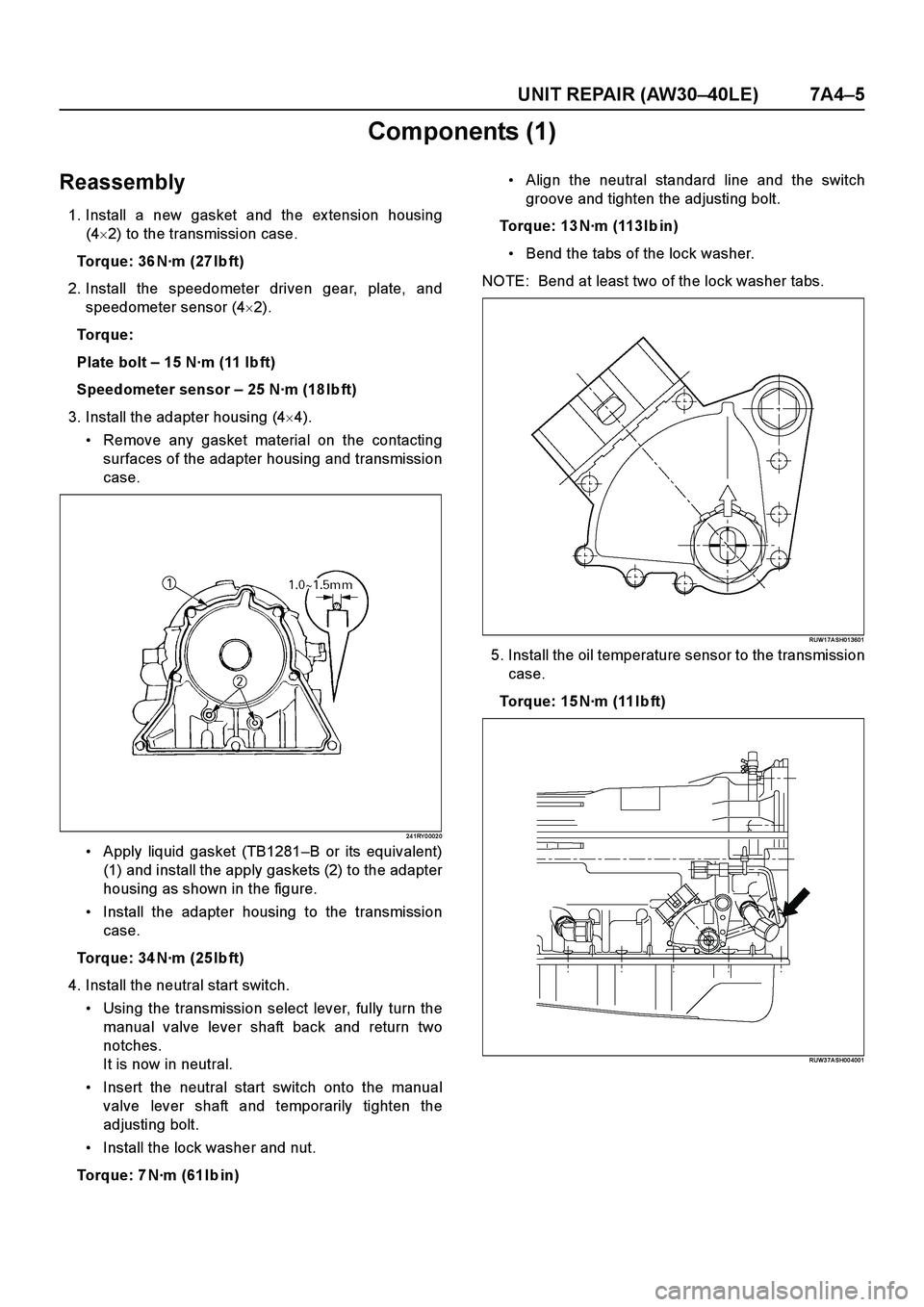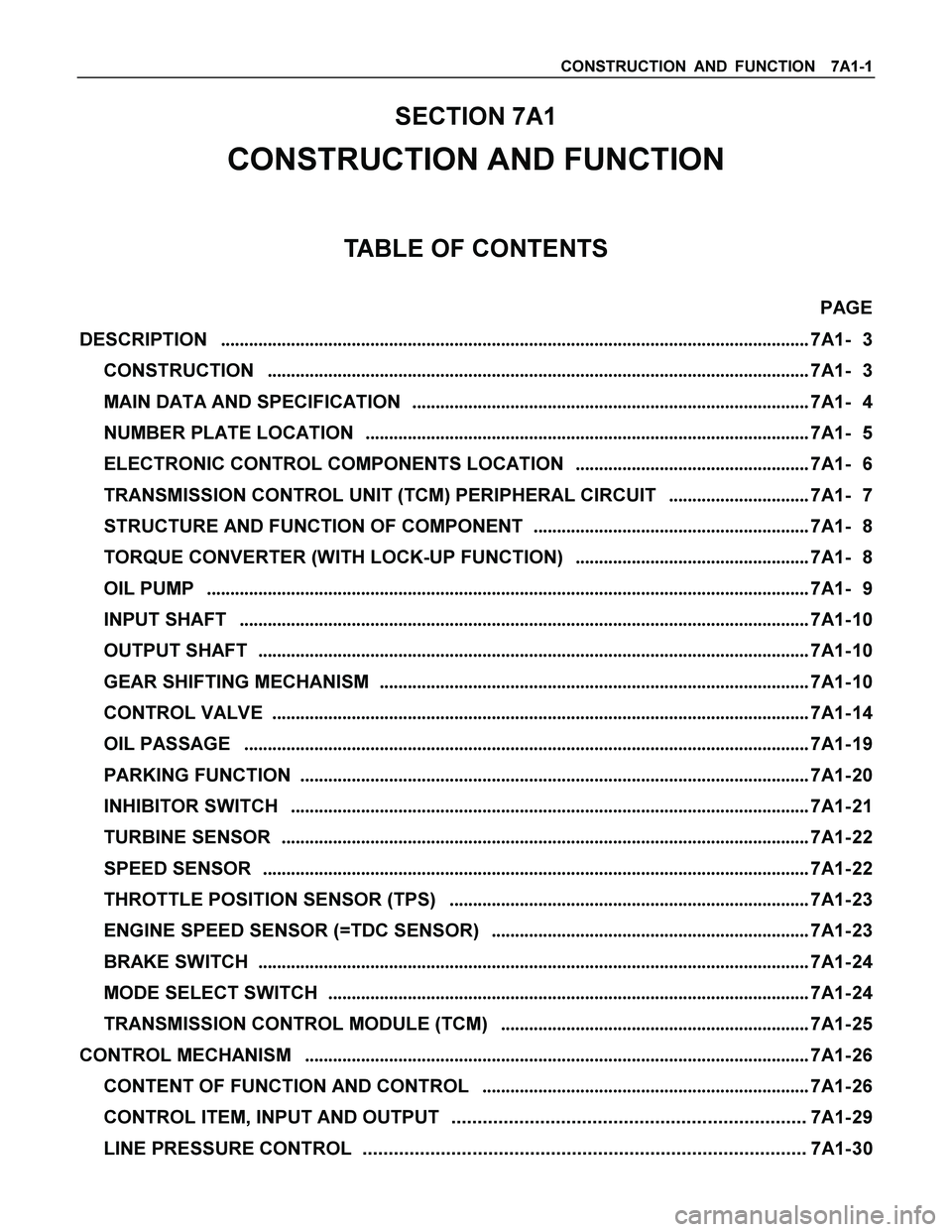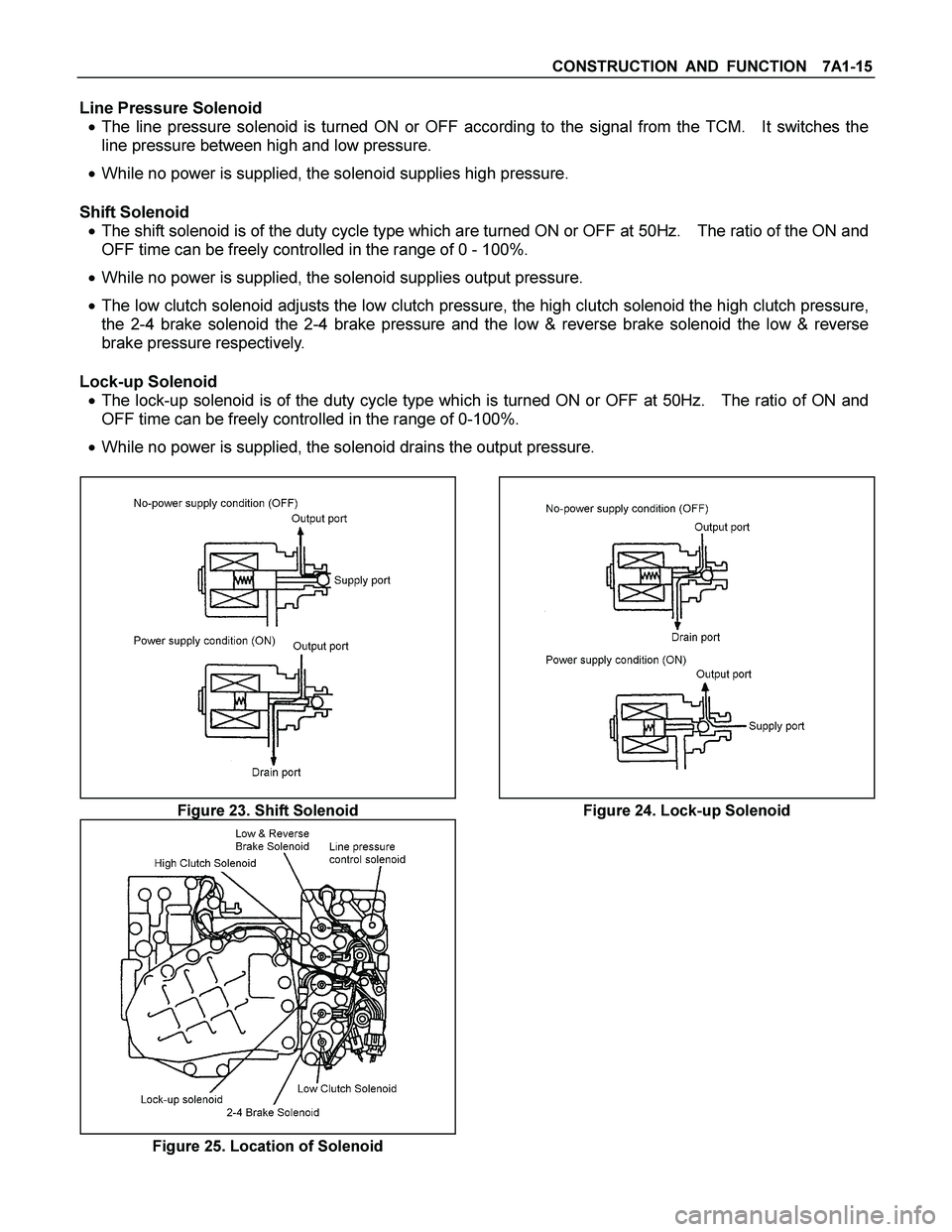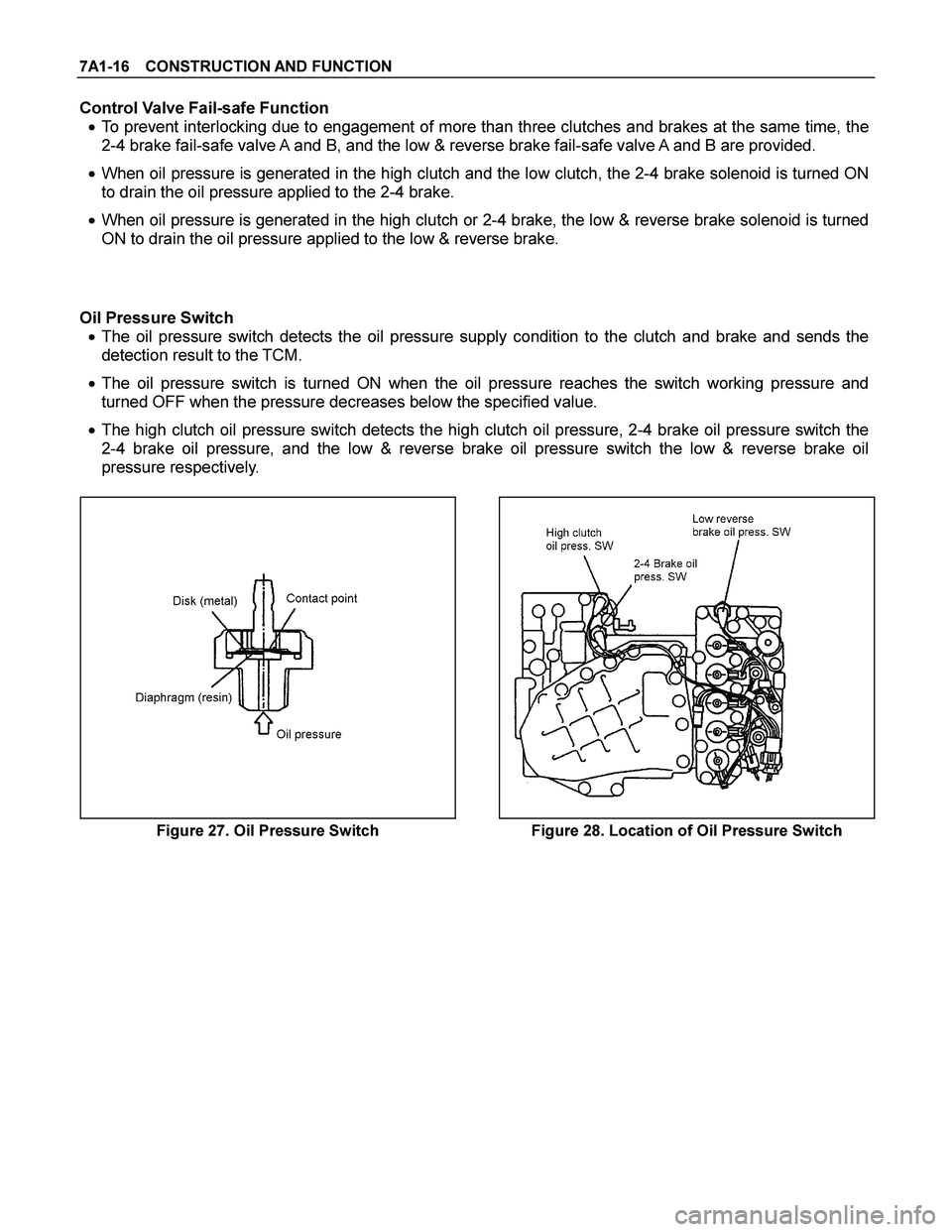Page 3813 of 4264

UNIT REPAIR (AW30–40LE) 7A4–5
Components (1)
Reassembly
1. Install a new gasket and the ex tension housing
(4�2) to the transmission case.
Torque: 36 N·m (27 Ib ft)
2. Install the speedometer driven gear, plate, and
speedometer sensor (4�2).
To r q u e :
Plate bolt – 15 N·m (11 Ib ft)
Speedometer sensor – 25 N·m (18 Ib ft)
3. Install the adapter housing (4�4).
Remove any gasket material on the contacting
surfaces of the adapter housing and transmission
case.
24 1RY 0 002 0
Apply liquid gasket (TB1281–B or its equivalent)
(1) and install the apply gaskets (2) to the adapter
housing as shown in the figure.
Install the adapter housing to the transmission
case.
Torque: 34 N·m (25 Ib ft)
4. Install the neutral start switch.
Using the transmission select lever, fully turn the
manual valve lever shaft back and return two
notches.
It is now in neutral.
Insert the neutral start switch onto the manual
valve lever shaft and temporarily tighten the
adjusting bolt.
Install the lock washer and nut.
Torque: 7 N·m (61 Ib in)Align the neutral standard line and the switch
groove and tighten the adjusting bolt.
Torque: 13 N·m (113 Ib in)
Bend the tabs of the lock washer.
NOTE: Bend at least two of the lock washer tabs.
RUW1 7A SH01 3601
5. Install the oil temperature sensor to the transmission
case.
Torque: 15 N·m (11 Ib ft)
RUW3 7A SH00 4001
Page 3947 of 4264

CONSTRUCTION AND FUNCTION 7A1-1
SECTION 7A1
CONSTRUCTION AND FUNCTION
TABLE OF CONTENTS
PAGE
DESCRIPTION ..............................................................................................................................7A1- 3
CONSTRUCTION ....................................................................................................................7A1- 3
MAIN DATA AND SPECIFICATION .....................................................................................7A1- 4
NUMBER PLATE LOCATION ...............................................................................................7A1- 5
ELECTRONIC CONTROL COMPONENTS LOCATION ..................................................7A1- 6
TRANSMISSION CONTROL UNIT (TCM) PERIPHERAL CIRCUIT ..............................7A1- 7
STRUCTURE AND FUNCTION OF COMPONENT ...........................................................7A1- 8
TORQUE CONVERTER (WITH LOCK-UP FUNCTION) ..................................................7A1- 8
OIL PUMP .................................................................................................................................7A1- 9
INPUT SHAFT ..........................................................................................................................7A1- 10
OUTPUT SHAFT ......................................................................................................................7A1- 10
GEAR SHIFTING MECHANISM ............................................................................................7A1- 10
CONTROL VALVE ...................................................................................................................7A1- 14
OIL PASSAGE .........................................................................................................................7A1- 19
PARKING FUNCTION .............................................................................................................7A1- 20
INHIBITOR SWITCH ...............................................................................................................7A1- 21
TURBINE SENSOR .................................................................................................................7A1- 22
SPEED SENSOR .....................................................................................................................7A1- 22
THROTTLE POSITION SENSOR (TPS) .............................................................................7A1- 23
ENGINE SPEED SENSOR (=TDC SENSOR) ....................................................................7A1- 23
BRAKE SWITCH ......................................................................................................................7A1- 24
MODE SELECT SWITCH .......................................................................................................7A1- 24
TRANSMISSION CONTROL MODULE (TCM) ..................................................................7A1- 25
CONTROL MECHANISM ............................................................................................................7A1- 26
CONTENT OF FUNCTION AND CONTROL ......................................................................7A1- 26
CONTROL ITEM, INPUT AND OUTPUT .................................................................... 7A1- 29
LINE PRESSURE CONTROL ..................................................................................... 7A1- 30
Page 3952 of 4264
7A1-6 CONSTRUCTION AND FUNCTION
ELECTRONIC CONTROL COMPONENTS LOCATION
4WD Only 4WD Only
Instrument panel (Meter)
Speed meter (2WD Only)
Shift position indicator lamp
POWER DRIVE, 3rd START
indicator lamp
A/T OIL TEMP indicator lamp
CHECK TRANS indicator lam
p
Brake pedal
Brake Switch
Select lever
Power Drive
, 3rd Start select switch
Transmission Control Module (TCM)
Electrical source
Ignition
Battery voltage
Speed sensor
Turbine sensor
Inhibitor switch
ATF thermo sensor
High clutch oil pressure switch
2-4 brake oil pressure switch
Low & Reverse brake oil pressure
switch
Line pressure solenoid
Low clutch solenoid
High clutch solenoid
2-4 brake solenoid
Low & Reverse brake solenoid
Lock-up solenoid
Transmission
Transfer Control Module
Transfer
4L mode switch
Engine
Engine speed sensor
Throttle Position Sensor
Engine Control Module (ECM)
Data link connector
Page 3960 of 4264
7A1-14 CONSTRUCTION AND FUNCTION
CONTROL VALVE
� Employing the direct electronic control (Direct Electronic Shift Control: DESC) for the clutch pressure has
simplified the oil pressure circuit, reduced the number of functional components and made the control
valve compact.
� The control valve body is divided into the upper body and lower body. All solenoids, oil pressure switch
and ATF thermo sensor are installed to the lower body.
� Three-way valve type solenoids providing high responsibility are employed. Some of the solenoids are
switched between ON and OFF and others repeat ON and OFF at 50Hz (duty cycle system).
Functionally, some supply output pressure when power is not supplied and others drain the output
pressure.
� When the solenoid is driven based on the signal from the TCM, the oil pressure is changed. The valve is
operated by the difference of the oil pressure.
Figure 22. Construction of Valve Body
Page 3961 of 4264

CONSTRUCTION AND FUNCTION 7A1-15
Line Pressure Solenoid
� The line pressure solenoid is turned ON or OFF according to the signal from the TCM. It switches the
line pressure between high and low pressure.
� While no power is supplied, the solenoid supplies high pressure.
Shift Solenoid
� The shift solenoid is of the duty cycle type which are turned ON or OFF at 50Hz. The ratio of the ON and
OFF time can be freely controlled in the range of 0 - 100%.
� While no power is supplied, the solenoid supplies output pressure.
� The low clutch solenoid adjusts the low clutch pressure, the high clutch solenoid the high clutch pressure,
the 2-4 brake solenoid the 2-4 brake pressure and the low & reverse brake solenoid the low & reverse
brake pressure respectively.
Lock-up Solenoid
� The lock-up solenoid is of the duty cycle type which is turned ON or OFF at 50Hz. The ratio of ON and
OFF time can be freely controlled in the range of 0-100%.
� While no power is supplied, the solenoid drains the output pressure.
Figure 23. Shift Solenoid Figure 24. Lock-up Solenoid
Figure 25. Location of Solenoid
Page 3962 of 4264

7A1-16 CONSTRUCTION AND FUNCTION
Control Valve Fail-safe Function
� To prevent interlocking due to engagement of more than three clutches and brakes at the same time, the
2-4 brake fail-safe valve A and B, and the low & reverse brake fail-safe valve A and B are provided.
� When oil pressure is generated in the high clutch and the low clutch, the 2-4 brake solenoid is turned ON
to drain the oil pressure applied to the 2-4 brake.
� When oil pressure is generated in the high clutch or 2-4 brake, the low & reverse brake solenoid is turned
ON to drain the oil pressure applied to the low & reverse brake.
Oil Pressure Switch
� The oil pressure switch detects the oil pressure supply condition to the clutch and brake and sends the
detection result to the TCM.
� The oil pressure switch is turned ON when the oil pressure reaches the switch working pressure and
turned OFF when the pressure decreases below the specified value.
� The high clutch oil pressure switch detects the high clutch oil pressure, 2-4 brake oil pressure switch the
2-4 brake oil pressure, and the low & reverse brake oil pressure switch the low & reverse brake oil
pressure respectively.
Figure 27. Oil Pressure Switch Figure 28. Location of Oil Pressure Switch
Page 3964 of 4264
7A1-18 CONSTRUCTION AND FUNCTION
Terminal Assembly
Pin No. Connected to Connected TCMPin No.
6 Line Pressure Solenoid B23
12 Low & Reverse Brake Oil Pressure Switch B12
5 Low & Reverse Brake Duty Solenoid B6
11 Ground Return B22
4 Lock-up Duty Solenoid B17
10 High Clutch Duty Solenoid B8
3 Low Clutch Duty Solenoid B9
9 2-4 Brake Duty Solenoid B7
2 Oil Thermo Sensor B4
8 Oil Thermo Sensor Ground B14
1 High Clutch Oil Pressure Switch B20
7 2-4 Brake Oil Pressure Switch B1
123456
891011127
Terminal Assembly Inhibitor Switch
Figure 31. Pin Assignment Figure 32. Location of Terminal Assembly
Page 3967 of 4264
CONSTRUCTION AND FUNCTION 7A1-21
INHIBITOR SWITCH
� The inhibitor switch is installed on the right side of the transmission main unit to detect the select lever
position.
� The inhibitor switch is connected with the starter SW circuit. The engine cannot be started when the
select lever is at any position other than the P or N range.
� By moving the select lever, the combination of the inhibitor switch pins is changed. The current range of
TCM is detected based on the combination of the pins.
10 7 3 2 4 8 5 1 9 6
P
R
N
D
3
2
L
6345
10987
21
Terminal Assembly Inhibitor Switch
Figure 36. Pin Assignment Figure 37. Location of Inhibitor Switch